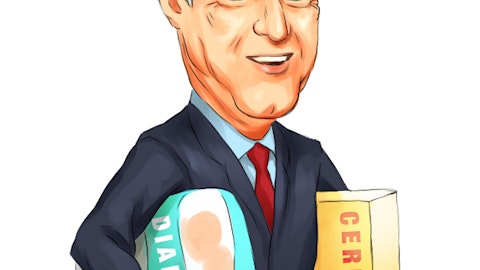Sinclair Broadcast Group, Inc. (NASDAQ:SBGI) Q4 2022 Earnings Call Transcript February 22, 2023
Operator: Greetings. Welcome to the Sinclair Fourth Quarter 2022 Earnings Conference Call. At this time, all participants are in a listen-only mode. A question-and-answer session will follow the formal presentation. Please note, this conference is being recorded. I will now turn the conference over to your host, Lucy Rutishauser, Executive Vice President and Chief Financial Officer. Ma’am, you may begin.
Lucy Rutishauser: Thank you, operator. Participating on the call with me today are Chris Ripley, President and CEO; Rob Weisbord, President of Broadcast and Chief Operating Officer; and Steve Zenker, Senior Vice President of Investor Relations. Before we begin, I want to remind everyone that slides and supplemental information for today’s earnings call are available on our website, sbgi.net, on the Investor Information page and on the earnings webcast page. Billie-Jo McIntire will make our forward-looking statement disclaimer.
Billie-Jo McIntire: Certain matters discussed on this call may include forward-looking statements regarding, among other things, future operating results. Such statements are subject to a number of risks and uncertainties. Actual results in the future could differ from those described in the forward-looking statements as a result of various important factors. Such factors have been set forth in the company’s most recent reports as filed with the SEC and included in our fourth quarter earnings release. The company undertakes no obligation to update these forward-looking statements. The company uses its website as a key source of company information, which can be accessed at www.sbgi.net. In accordance with Regulation FD, this call is being made available to the public.
A webcast replay will be available on our website and will remain available until our next quarterly earnings release. Included on the call will be a discussion of non-GAAP financial measures, specifically adjusted EBITDA, adjusted free cash flow and leverage. The company considers adjusted EBITDA to be an indicator of the operating performance of its assets. The company also believes that adjusted EBITDA is frequently used by industry analysts, investors and lenders as a measure of valuation. These measures are not formulated in accordance with GAAP and are not meant to replace GAAP measurements and may differ from other companies’ uses or formulations. The company does not provide reconciliations on a forward-looking basis. Further discussions and reconciliations of the company’s non-GAAP financial measures to comparable GAAP financial measures can be found on its website, www.sbgi.net.
In addition, given the deconsolidation of Diamond on March 1, 2022, and in order to have a meaningful discussion around comparative results and trends, all discussions of prior financial period results during this call reflect Sinclair only pro forma numbers, and thus, exclude Diamond and any intercompany transactions with them and exclude businesses sold in the prior 12 months. Our actual results, including the periods the time it was consolidated, please refer to this morning’s earnings release. Chris Ripley will now give an update on the strategic direction of the company.
Chris Ripley: Good morning, everyone. Sinclair had a solid finish to 2022, capping a year which set records for our broadcast and other total advertising revenues, distribution revenues and media revenues. Political ad sales for the year surpassed the previous midterm election year by over 30%, demonstrating the strong value proposition that TV continues to offer to political candidates and issue advocates. The strength certainly bodes well for the 2024 political season. Fourth quarter media revenues, adjusted EBITDA and adjusted free cash flow all fell within our guidance range. Rob and Lucy will cover the specifics on the quarter in just a bit. We entered 2023 financially strong position to weather any economic headwinds that maybe encountered, with $1.5 billion of liquidity and no debt maturities until well into 2026.
And with Diamond deconsolidated and operating independently of Sinclair, we can focus on our Broadcast business, Tennis Channel, growth networks, our four growth pillars and our investment portfolio. 2023 will be a year of investment on a number of fronts, including investments in technology. There are seven major areas, with that we are prioritizing, including news, next-gen related activities, ad-tech, content, customer data management, IT security and our ongoing move of our operations into the cloud. These new initiatives, which total approximately $75 million of spend in 2023, will allow us to essentially manage our entire enterprise, enabling greater quality, productivity and efficiency by sharing content workflows and manpower across our entire organization helping drive future profitability.
We continue to make progress in moving forward the next-gen broadcast technology in conjunction with our partners. As of the end of 2022, nearly two-thirds of the households in Sinclair’s footprint had NEXTGEN broadcast available to them. Building on the testing and validation progress that was made in 2022, we are ramping up spending in 2023 on initiatives around the new technology, which we expect to begin to generate revenues in 2024. These initiatives include continuing the progress on testing the NEXTGEN broadcast technology for automotive applications with Hyundai Mobis, SK Telecom and CAST.ERA. Late in 2022, we participated in a demonstration with these partners around in-vehicle video, including advanced geo-targeting capabilities for advertising.
This collaboration was the first under an MOU we have with Hyundai Mobis and we continue our important work with Saankhya Labs. We are currently collaborating with them on several projects, including chips for mobile devices, direct-to-mobile services and cellularized broadcast radio heads. This year Tennis Channel celebrates the brand’s 20th anniversary, building on its 2022 successes for what we hope is an even bigger 2023. After a breakthrough year, launching its national fast channel exclusively on Samsung TV Plus, T2 Sinclair’s second original 24/7 Live Pro Tennis Network, will now begin rolling out on other free streaming platforms, expanding total homes reached by tens of millions and TC International’s worldwide regional platform expansion plans continue with France, Spain, Australia and Latin America, all targeted new markets.
Pickleball continues its phenomenal growth trajectory and Tennis Channel is now delivering this pro and participatory sport, including all the top professionals, celebrity-led teams and grassroots excitement to more viewers than ever in 2023. As previously discussed, we expect our net retrans to grow over the next three-year period, but will do so at differing rates. With 50% of our big four subscribers renewing in the second half of 2023 and another 40% front-end loaded in 2024, we expect net retrans to decline in 2023, but grow in 2024 and 2025, such that our three-year CAGR grows low single-digit percentage. When considering the investments we are making in 2023, along with the timing of our retrans renewal cycle and the absence of political revenues, we expect EBITDA in 2023 to be lower than 2022.
We also expect lower free cash flow as a result of these factors as well as the absence of a large tax refund received in Q4 of 2022. Lucy will go over the details of what we expect in 2023 in her section. In terms of our investment portfolio, during the fourth quarter, we received distributions of $23 million and made investments of $8 million. For all of 2022, the portfolio generated $119 million in cash distributions to us, consisting of return of capital of $38 million and $81 million of gains from sales and distributions of excess profits. Factoring in $33 million of investments made during the year, net cash generated from the investment portfolio for the year was $86 million. We remain committed to monetizing our assets where appropriate to benefit all our shareholders.

Photo by Jacob Hodgson on Unsplash
As a reminder, the assets we acquired since 2014 in this portfolio have generated an IRR of approximately 19%. Despite the strong track record and what we estimate to be a fair market value of $1.2 billion, we believe there is approximately $17 per share of value from these investments not reflected in the stock price. Before I turn it over to Rob, I want to touch on a few other areas. Regarding our ESG activities, at the end of 2022, we have converted almost half of our lighting to LED and have also transitioned over 70% of our transmitters and 38% of our HVAC units to higher efficiency solutions. These actions should significantly reduce our energy usage. This year, we plan to begin working with an outside firm to analyze our current and past energy usage and make recommendations to lower our electricity costs going forward.
This will allow us to formulate a baseline of energy consumption and report out energy usage targets and actual savings in the future. In 2022, we helped raise close to $12 million in funds for non-profits, schools, local disaster relief and other charitable causes, partnering with over 300 local organizations and conducting company-wide campaigns with Feeding America, Project RELO and Global Red Cross. We also collected more than 330,000 pounds of food, provided close to 4.5 million meals and collected over 400,000 toys, diapers and hygiene products for those in need, and donated over 5,700 hours of airtime and public service messaging. In 2023, we’ll be launching a new charitable program where Sinclair will match certain employees’ donations to registered charities.
In addition, Sinclair will be launching a company-wide Sinclair Day of Service in April, encouraging all of our employees to dedicate the day to strengthen entire to their communities. These actions are just the latest chapter in Sinclair’s unwavering support of the people and communities that we serve. As we enter 2023, the economic climate continues to be uncertain as to whether the economy would enter a recession. And today, we still have a little clarity on the economy’s direction. However, we have been taking steps to deal with whatever direction consumer demand takes. We’ve been curbing our expenses without impacting the growth initiatives I have mentioned earlier. One final note, regarding the loss of carriage on of our CBS stations on FUBO, as you may recall, the networks control these negotiations and affiliates are not currently permitted by the networks to negotiate the carriage of our stations with virtual distributors.
The networks negotiate these agreements and then give us an opt-in to whatever terms they come up with. If we don’t opt in, they provide a national fee. In this instance, the CBS Affiliate Board unanimously believe that the offer CBS presented at the broadcast stations meaningfully undervalued the important local content that our stations provide. FUBO is also seemingly getting caught in the crossfire here, so to speak, as it’s our understanding that they were not given the opportunity to negotiate with us directly. We welcome the opportunity to come up with a more equitable solution and continue to believe we should have the ability to negotiate with these agreements ourselves as we do with the hundreds of legacy cable, telco and satellite companies with no interference from the networks.
I’ll now turn it over to Rob.
Rob Weisbord: Thank you, Chris. The air trends we saw in the fourth quarter was not unexpected with political setting a midterm record and core advertising relatively even with a year ago or down mid-single digits when adjusting for the cyber incident in 2021’s fourth quarter. Of course, political crowd out was the primary reason for core being down. While we don’t have good comps on category color by month versus the prior year, due to the cyber incident, we can look to four years ago to get an idea of how the quarter played out pre and post the elections. Post-elections December was a weak month versus four years ago, and that weakness has extended into the first quarter of this year, albeit at a lower percentage decline. Pacing for January and February is down low single digits versus last year, aided by the Super Bowl running on the Fox this year.
While March is pacing down slightly higher, but the month has not broken yet. For the first quarter of 2023, we are seeing growth in several categories, including auto, legal and entertainment and sports betting is relatively flat, an improvement from last year’s trend as new gaming markets recently came online in Ohio and Maryland. Services continues to be weaker on insurance ad declines. Pharmaceuticals and food are some of the other large categories exhibiting weaknesses. We saw good ad demand for the Super Bowl, which was on our 41 FOX affiliates earlier this month. In 2023, we expect our newly implemented yield management tools to help us better understand our advertising revenue dynamics, allowing us to more effectively analyze our ad units and inventory sellout levels across all our platforms and to optimize our pricing.
Also, the first phase of our unified ad platform will be launching sometime in March. We are also working with Anthony Zuiker, the creative visionary of numerous popular entertainment shows, including CSI on entertainment and original news programming episodes. Finally, I would like to thank the field for the fundraising that Chris mentioned earlier in generating $12 million for our communities in charity donations. Now, I will turn it over to Lucy for the financials.
Lucy Rutishauser: Thank you, Rob. So as a reminder, you can follow along with our slide deck and our financial supplements on our website. Also as a reminder, in the fourth quarter of 2021, we experienced a cybersecurity ransomware incident, which negatively impacted media revenues by approximately $63 million in that period. Turning to the fourth quarter of 2022, media revenues were up 19% versus the same period a year ago, driven by higher political ad revenues and higher core advertising, offset by lower distribution revenues and a lower management fee. Adjusting for the cyber incident impact, media revenues would have been up 10%. For the year, media revenues were also up 10% or almost 8% cyber adjusted. Total advertising for the quarter and year were record highs, driven by strong political revenues.
As compared to the last midterm election year in 2018, total advertising was up 3% for both the quarter and the year. Total advertising for the fourth quarter increased almost 60% over 2021, were up 31% when adjusting for the cyber incident. Core advertising, adjusted for the cyber incident, declined high single digits on political crowd-out, which is expected given the record levels of political. The $952 million of media revenues was within our guidance range with political slightly under guidance and core advertising at the high end of guidance. Distribution revenue decreased 2% versus last year, slightly below our guidance range, primarily due to higher-than-expected subscriber churn, which continues to be in the mid-single-digit range year-over-year.
Media expenses were 7% higher in this year’s fourth quarter versus last year, on higher network programming fees, higher sales expense on the favorable revenue and higher G&A expenses, but were favorable to guidance. Adjusted EBITDA for the quarter grew over the fourth quarter of last year, mainly on the strength in political revenues, partially offset by the Diamond management fee deferral and the higher expenses discussed. As compared to guidance, our $309 million of adjusted EBITDA came in at the high end of our guidance range. For the year, pro forma adjusted EBITDA was $890 million. Adjusted free cash flow in the quarter also was within our guidance range with adjusted free cash flow per share of approximately $5.75 for the quarter and diluted earnings per share of $0.79.
The quarter benefited from $158 million of tax refunds related to prior year audits. For the year, pro forma adjusted free cash flow was $847 million, representing a 95% adjusted EBITDA conversion ratio and over $11.50 per share. We increased our cash balance by $277 million during the quarter for an ending balance of $884 million. And when combined with our undrawn revolver put our liquidity at more than $1.5 billion at quarter end. Looking back over 2022, we took several actions to increase shareholder value, including raising our dividend by 25% when annualized $1 per share; buying back approximately 5 million shares or 7% of our shares outstanding; and repurchasing $118 million of face value of our 2027 notes at a discount. This month, we purchased the remaining outstanding Diamond preferred units, which had a coupon of over 12% and for which Sinclair had a guarantee of collection.
The units were purchased for $190 million, which was at a 5% discount to their accretive value. Total debt at the end of the fourth quarter was $4,265 million, and STG’s first-lien indebtedness ratio on a trailing eight quarters was 3.1x, while total net leverage through the bond was 4.0x. Turning to our first quarter 2023 guidance. As it relates to comparisons to Q1 of 2022, we will talk to proformas, which exclude Diamond, which was deconsolidated in March of 2022, and therefore, was in two months of our actuals last year. We expect media revenues to decrease approximately 6% to 9% versus first quarter 2022’s proforma media revenues of $818 million. First quarter’s core advertising is expected to be flat to down mid-single-digit percent versus first quarter of last year, with the decline in core primarily driven by mild macroeconomic weakness.
Media expenses are expected to be $604 million to $610 million for the quarter and $2,392 million to $2,407 million for the year, which includes roughly $75 million for new investments in technology and our pillars of growth that Chris discussed. First quarter adjusted EBITDA is expected to be between $99 million and $113 million compared to $200 million pro forma last year, with the decline primarily the result of the absence of political lower net retrans as discussed and the management fee change. Adjusted free cash flow for the quarter is expected to be $43 million to $59 million. And with that, I would like to open it up to questions. Operator?
See also 10 Best March Dividend Stocks to Buy and 12 Most Promising Future Stocks to Buy.
Q&A Session
Follow Sinclair Broadcast Group Inc (NASDAQ:SBGI)
Follow Sinclair Broadcast Group Inc (NASDAQ:SBGI)
Operator: Your first question for today is coming from Dan Kurnos at Benchmark.
Dan Kurnos: Great. Thanks. Good morning. Chris, thanks for all the really helpful color, especially around retrans net retrans in the Fubo deal. I don’t know if there’s any additional color beyond what you stated that you can give on whether the network was trying to clawback incremental economics or if it really was and arguments around your ability to negotiate with the virtuals, which I know has been sort of a lobbying point for the broadcasters. It makes a ton of sense. So maybe that first. And then in addition on the outlook, helpful on the timing of subs. Your guide still low singles on net retrans. Can you talk a little bit more about sort of the interplay as you see it between either mix or rate as well as how much reverse is coming down to be confident in that outlook?
ChrisRipley: Sure. So on your first question related to Fubo, it is financially not a very impactful situation given the size of Fubo. But as I mentioned in my remarks, the affiliate board concluded that the offer was just meaningfully undervalued the global content that our stations provide. And that was really the main driver of the decision. That being said, I will say that there’s a growing consensus within the broadcast community and also within D.C. that this situation with the virtuals, it needs to change, that it really is not consistent with the way the industry is set up and the way market power should be used. So that’s what I’ll say on Fubo. And then as it relates to your question on retrans, I’ll restate what we said, which is that we are expecting a down year on net retrans here in 2023, but up in 2024 and 2025.
Our three-year CAGR is low single digits over that period. What is, I think, important to understand in terms of the dynamics and you touched on this in your question is that the growth of reverse retrans has significantly moderated over the last year or so. So you’re not seeing this dynamic where the growth rates on both gross and reverse being all that different.
Dan Kurnos: Got it. And if I could ask one more, just, Chris, on your expense guide. How do we think about kind of the ROI? How much of the $75 million is what we would consider sort of onetime? And then when will we really start to see the flow through either to revenue or EBITDA, if it’s like a cloud migration as you mentioned?
ChrisRipley: Right. So the $75 million that we’re spending is largely on transformation efforts and what a big part of that this year will be our moves to the cloud, which does result in significant OpEx and CapEx savings in the forward years starting in 2024, but really starting making a big impact to 2025 and beyond. And so they do we wouldn’t be spending needs if they didn’t have either a commensurate cost savings in the future or a capability that we needed to enhance revenues or growth opportunities. And this will be the heaviest year in terms of that transformation spend, and it will start to on a net basis versus the benefits come down in 2024 and start to really pay off thereafter.
Dan Kurnos: Got it. Great. Thanks for all the color. Appreciate it.
Operator: Your next question for today is coming from Barton Crockett of Rosenblatt Securities.
Barton Crockett: Okay. And thanks for taking the question. I appreciate now that you’re guiding for some revenues to come from NextGen, ATSC in 2024. And I was wondering if you could give us since it’s just kind of, hopefully, the start of the new era, a little bit more color. I mean, is this kind of start really small, noticeable? Where do you see the revenues kind of starting? And how do you see the momentum playing out for that from the start of 2024 going forward?





